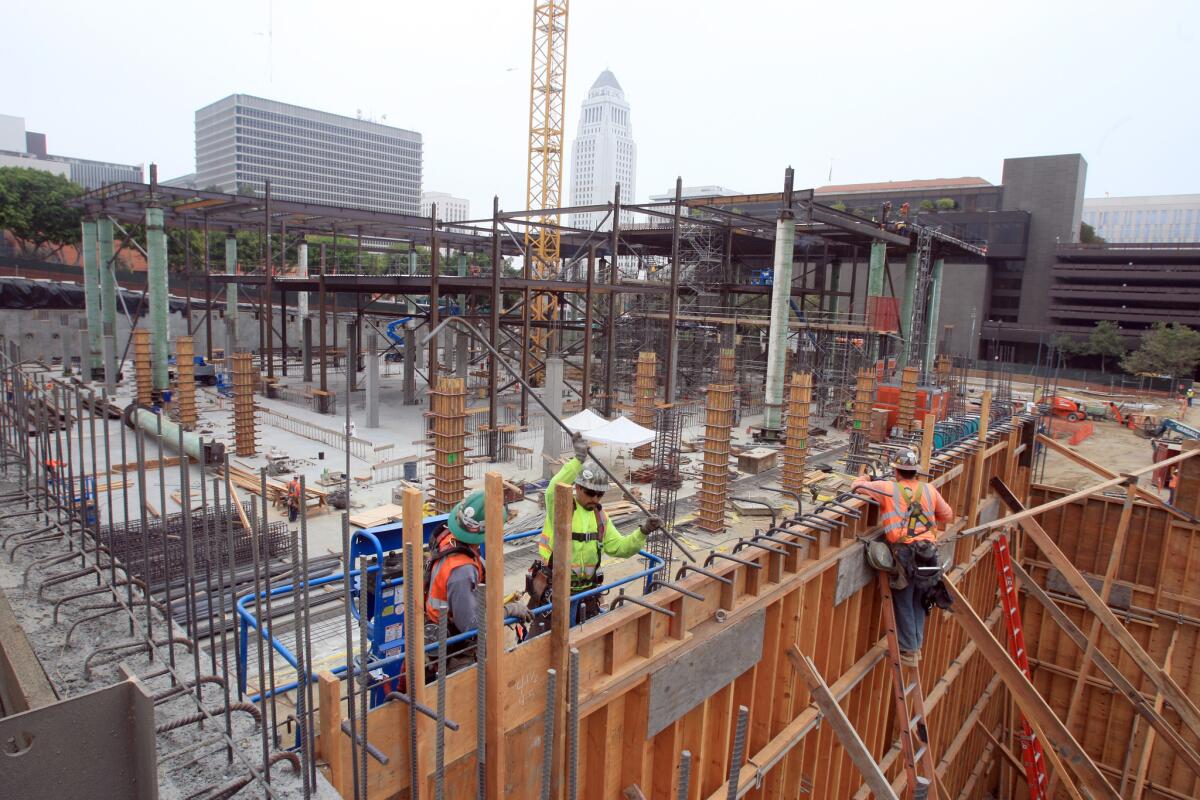A sunny outlook for jobs in the Golden State

Over the last year, the construction industry has sped up hiring, a welcome sign for a sector of the economy that was decimated by the housing bust. Above, a crew works on a new courthouse in downtown Los Angeles.
- Share via
The economic news for California lately has been worrying. Turmoil in the markets of China, one of the state’s largest trading partners. A punishing drought that has left a half-million acres of farmland fallow this year. A “business climate” that perpetually ranks near the bottom in national surveys.
But a recent series of economic forecasts paints a different picture. The economy and job market are growing faster in California than the U.S. overall, those reports say, and that trend is expected to continue over the next few years.
Recent high-profile obstacles to economic growth — whether real or perceived — pale in comparison to the state’s position as a magnet for well-educated entrepreneurs, a hub for trade with the Pacific Rim and the center of the technology boom.
Christopher Thornberg, founding partner of Beacon Economics in Los Angeles, offers a simpler explanation.
“The answer is: People want to live here,” he said. “It’s amazing what you can get away with on that.”
The state’s unique climate and geographical delights continue to attract wealthy visitors and immigrants from around the globe.
The Great Recession sent California’s unemployment rate higher than in all but two states, Michigan and Nevada. But its recovery was swift. Economists’ recent projections call for job and GDP growth that will consistently outpace the U.S. through at least 2017, bringing California’s unemployment rate well below its long-run average.
A recent economic forecast from UCLA projects that California’s unemployment rate will fall to 4.8% by 2017, down from a high of more than 12% in 2010.
California’s regulatory environment often stirs the ire of the business community, causing the state to land at or near the bottom of many “business-friendly” rankings. Chief Executive magazine has perennially put California at No. 50, calling it a “deeply troubled state” where businesses are “so highly regulated that most cannot afford to do business.”
Former Texas Gov. Rick Perry made a hobby of flying to California to woo businesses to his state. Last year he showed up in Sacramento driving a Tesla Model S as part of an ultimately failed bid to persuade the maker of electric cars to build a battery factory in the Lone Star state. (The factory went to Nevada, which offered the Palo Alto automaker a lavish incentive package.)
But for the last three years, California has added jobs at a rate faster than all but five other states — and since last year it has significantly outpaced Texas.
U.S. Census migration data show that, despite higher personal and corporate income taxes in California, more people making $200,000 or more are moving to California than are leaving.
All economies have their ups and downs, and forecasting can be an imprecise science. Economists also point to long-term structural challenges that remain: the state’s unfunded pension liabilities and a chronic under-supply of housing that makes many California real estate markets among the most expensive in the nation.
The rosy outlook doesn’t mean that California’s high regulatory costs have no effect on business decisions in the state. Many point to California’s much slower job growth in manufacturing — an energy-intensive industry that must comply with strict environmental regulations — as evidence that the state’s business climate is pushing some firms out.
But economists who have reviewed such rankings say there is rarely a direct correlation between a state’s “business climate” — typically defined as the level of corporate taxes and regulatory costs — and its broader economic performance. A study from the Public Policy Institute of California in 2011 found that the factors most influencing a state’s economic performance are largely “beyond the reach of public policy.”
Much more important, according to the study, are factors that favor California: weather, geography and a diverse mix of industries.
Not surprisingly, economic growth has been swiftest in Silicon Valley, San Francisco and San Diego — hubs for innovation in the technology, software and life sciences industries.
The San Francisco Bay Area was the first region in California to begin picking up steam after the Great Recession. The growth of tech jobs there and in parts of Southern California spawned additional demand for workers in the professional and technical services sector — lawyers, accountants, consultants and architects needed to support new business activity.
Over the last year, the construction industry has also sped up hiring, a welcome sign for a sector of the economy that was decimated by the housing bust. There are still far fewer construction jobs now than in 2006, at the peak of the housing boom, but economists say the return of construction jobs fills a crucial niche in the job market: higher pay for workers who may not have college degrees.
Lance Carlson, principal at Orange County architecture firm Taylor Design, has seen the growth firsthand. As the economy has improved over the last few years, the firm has opened a new office in San Diego and has expanded its primarily healthcare-driven practice into the science, technology and education industries.
The Affordable Care Act, in particular, has driven healthcare companies to rethink the way they interact with patients, Carlson said. That has led to a building and renovation boom in the industry.
Hiring has been difficult, he said, because so many companies are chasing top talent in the design world.
“We have this burgeoning creative sector,” Carlson said. “There’s a critical mass of people here doing this kind of work. It’s just fertile.”
External pressures on the California economy, such as the slowdown in China and the drought, are not expected to have widespread impact on growth in a $2.3-trillion state economy.
Record volumes at the ports of Los Angeles and Long Beach have fueled significant job growth in warehousing and goods movement, and that growth is tied to imports driven by consumer appetites in the U.S.
Exports could suffer in the short term if spending in China slows down, but U.S. exports to China represent less than 1% of U.S. GDP.
Experts suggest the trouble overseas could actually benefit the state, as wealthy Chinese move money into California real estate.
“With the dismal outlook and uncertainties in China, contrasted with the promising and stable outlook in the U.S., it is wise to reallocate money from China to the U.S.,” William Yu, an economist with the UCLA Anderson Forecast, concluded in a paper released Monday.
When Gov. Jerry Brown announced sweeping mandatory reductions in water use last spring, some questioned whether the California dream was over. But since then, cities across the state have adapted to the drier new reality by reshaping the way they operate.
Though California produces more than a third of the nation’s vegetables and two-thirds of its fruits and nuts, the agriculture industry represents about 2% of the state’s GDP. Some farm owners and workers are no doubt losing money, but their hardships aren’t expected to have much of an effect on the overall state economy.
And much of the agriculture industry is weathering the extended dry spell. Average employment in the industry this year is down only about 1% from the same period last year. The number of agriculture jobs in the state is about 10% higher than a decade ago, according to state employment data.
The strong overall growth of the state’s economy, however, makes it harder to see the suffering in particular industries and regions.
The extraordinary success of high-tech industries in coastal California masks the struggles of inland regions with elevated unemployment, said Loren Kaye, president of the California Foundation for Commerce and Education, which is affiliated with the state Chamber of Commerce.
Small businesses in those parts of the state, which might provide opportunities for lower-skilled workers, are particularly squeezed by California’s high costs of energy and statutory protections for workers, he said.
“When you generalize about the economy, things look pretty good. But there’s a huge amount of variation,” Kaye said. “When we talk about the business climate, it’s really a matter of how do you allow other parts of the state to become as prosperous as the good parts of California.”
While some smaller-margin businesses may find California unattractive, the state’s sheer size remains attractive for retailers and other businesses looking to gain a foothold in the most populous state.
“When you say possession is nine-tenths of the law, this is possession. We have the people,” said Stephen Sherline, a senior vice president at U.S. Bank in Los Angeles. “That means there’s going to be more opportunities to sell things to people in California.”
More to Read
Inside the business of entertainment
The Wide Shot brings you news, analysis and insights on everything from streaming wars to production — and what it all means for the future.
You may occasionally receive promotional content from the Los Angeles Times.











